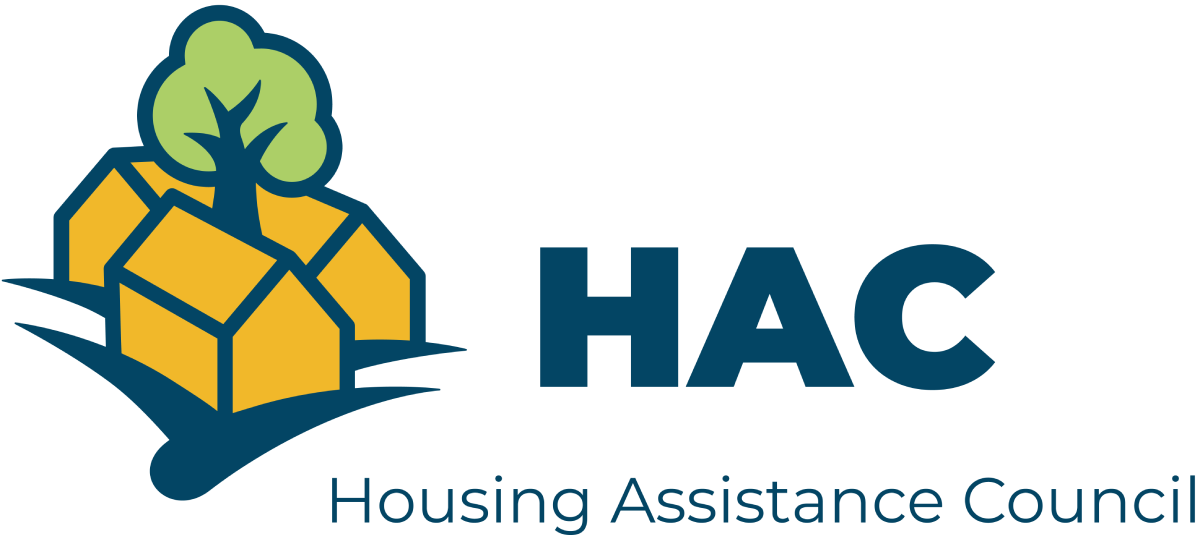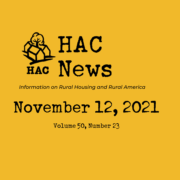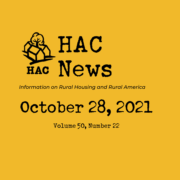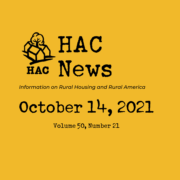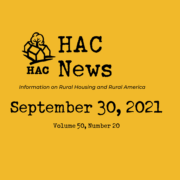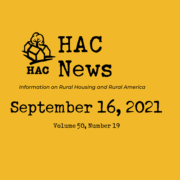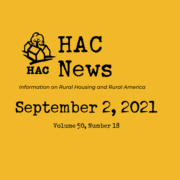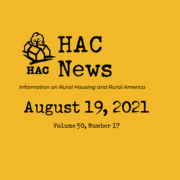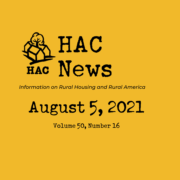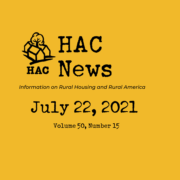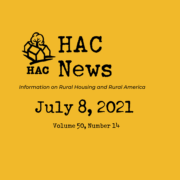HAC News: November 12, 2021
Vol. 50, No. 23
TOP STORIES
Bipartisan infrastructure bill passes, social spending measure still pending.
On November 5 the House passed the $550 billion funding measure for traditional infrastructure, including rural broadband. It was approved by the Senate on August 10 and President Biden is scheduled to sign it into law on November 15. Also on November 5, the House agreed to move forward towards a vote on the Build Back Better social infrastructure bill, H.R. 5376, which includes funding for housing and the new Rural Partnership Program. A revised version of BBB, released November 3, added funds for some housing and development programs, including the Low Income Housing Tax Credit and the CDFI Fund. The House will continue its consideration of the bill after Congress returns from recess on November 15.
There’s still time to register for the 2021 Virtual HAC National Rural Housing Conference!
HAC invites you to join us virtually on November 30-December 3! This year’s conference features more than 30 workshops, where participants will interact and engage around best practices for rural housing and community development, organizational management, and resource development. The conference also includes a pre-conference day with gatherings for coalitions, associations, and working groups. For more information, contact HAC staff, 404-892-4824.
Joaquin Altoro appointed as Rural Housing Service Administrator.
USDA announced on November 8 that Joaquin Altoro will serve as the RHS Administrator. He has been CEO and Executive Director for the Wisconsin Housing and Economic Development Authority.
HAC’s Rural Voices magazine covers pandemic’s impact.
The pandemic is not over yet, but this issue, titled Creating the New Normal: COVID-19 Leaves its Mark on Rural America, covers how affordable housing organizations have adapted to a new reality. Get insights on how rural renters, the colonias, farmworkers, and people experiencing homelessness have been impacted.
RuralSTAT
53% of American Indians or Alaska Natives in the U.S. live in rural America. Source: HAC tabulations of 2020 P.L. 94-171 Redistricting Data.
OPPORTUNITIES
New Markets Tax Credits available.
Applications are due January 13 for NMTC allocations, which can be used to attract private investment in economic and community development in low-income communities. Applicants must be certified Community Development Entities; apply for certification by November 18. For more information, submit a service request on the CDFI Fund’s site or call agency staff, 202-653-0421.
Grants will help historic places important to underrepresented communities.
The National Trust for Historic Preservation’s Telling the Full History Preservation Fund offers one-time grants to help interpret and preserve historic places of importance to underrepresented communities. Nonprofits, colleges and universities, state or local government agencies, and tribes are eligible and must have been adversely impacted by the coronavirus pandemic. Apply by December 15. For more information, contact National Trust staff.
Webinar to consider rural capacity building.
This Is What Capacity Looks Like: Building Development Muscle in Rural and Native Nation Communities, to be held November 30, will examine what key components of capacity need to be intentionally strengthened so that local organizations can strengthen their rural and Native nation communities, what it takes for them to build capacity, and what barriers stand in the way. This is one of the Rural Opportunity and Development (ROAD) Sessions, virtual exchanges co-designed and hosted by the Aspen Institute Community Strategies Group, HAC, the Rural Community Assistance Partnership, Rural LISC, and the Federal Reserve Board.
NEW! HAC seeks Loan Processor Associate, Housing Specialist, and Community Facilities Housing Specialist.
- The Loan Processor Associate is an entry-level position and will assist in managing HAC’s portfolio of loans made to entities engaged in affordable housing activities throughout the rural U.S. This position is eligible for telecommuting.
- The Housing Specialist is primarily based in either the Southwest or Western states (within two hours of a major airport) and works with local partner organizations to identify financial resources and funding opportunities to support the preservation and development of affordable housing and community and economic development strategies specifically throughout expanses of Southwest and/or Western rural America. This position is remote location eligible.
- The Community Facilities Housing Specialist identifies and engages community stakeholders and provides direct technical assistance to rural organizations that are developing facilities such as parks, community centers, public libraries and childcare centers. This is a two-year position and is eligible for telecommuting.
REGULATIONS AND FEDERAL AGENCIES
Agencies return to full enforcement of mortgage servicing protections.
Ending temporary flexibility they had instituted in April 2020, several federal and state regulatory agencies have announced they will enforce provisions requiring mortgage servicers to give families the chance to find alternatives to foreclosure before losing their homes. A Consumer Financial Protection Bureau statement notes that, with the majority of the over one million remaining pandemic-related forbearances expected to end before the end of the year, struggling homeowners will need these protections to avoid foreclosure.
USDA Rural Development requests comments on new forms.
Public comments are due January 4 on two sets of new forms for applicants. The Common Forms Package for Civil Rights Forms will collect information from funding recipients so RD can monitor their compliance with civil rights laws and regulations. The Common Forms Package for Real Estate Title Clearance and Loan Closing will collect information from recipients of funds involving real estate, including housing. For more information, contact Lynn Gilbert, USDA, 202-690-2682.
RISE rule for jobs accelerators is final.
USDA’s Rural Innovation Stronger Economy Grant Program interim final rule received no substantive comments, so it was finalized without changes. For more information, contact David Chestnut, USDA, 202-692-5233.
PUBLICATIONS AND MEDIA
Learn about veterans in your community.
HAC’s Veterans Data Central is newly updated with data from the Census Bureau and other sources. This on-line resource is easy to use and provides essential information on the social, economic, and housing characteristics of veterans in the U.S. This data can help support sound strategies and policies to assist veterans.
New analysis shows what states may lose unspent Emergency Rental Assistance funds.
Emergency Rental Assistance Spending and Performance Trends, published by the National Low Income Housing Coalition, reports that 28% of grantees have spent less than 30% of their allocations under the first portion of the Treasury Department’s Emergency Rental Assistance program and may be at risk of losing funds through reallocation. This includes 32 states (63% of state grantees) and 80 localities (23% of local grantees). The report analyzes grantee spending progress, describes Treasury’s process for reallocating funds, and provides recommendations to ERA administrators and Treasury to best serve low-income renters.
Booming housing sales affect trends in rental market, zoning, and housing availability.
Recent reports, including by Politico and Forbes, look at rises in housing costs. Forbes notes that housing sales continue to boom across the country. The lack of availability of starter homes has led to high demand in the rental market, with trending rent increases. Some states are changing single-family home zoning laws, apartments are being built with less square footage, and an increased allowability of tent cities across the country aims to provide housing in an increasingly expensive housing market. While the Forbes piece does not identify differences between urban and rural places, a new data analysis from the Center for Rural Pennsylvania verifies anecdotal reports about increased home sales in that state’s rural counties, while sales have fallen in its urban areas.
Postal Service plan for cost savings raises concerns about disproportionate rural impacts.
Researchers who study the U.S. Postal Service raise concerns about possible “catastrophic” impacts for rural communities due to cost cutting efforts in a recent article in the Daily Yonder. Citing a National Farmers Union statement, the article notes that rural residents disproportionately depend on the Postal Service to receive medication, vote, communicate with friends and family, cash checks, and conduct business.
Need capital for your affordable housing project?
HAC’s loan fund provides low interest rate loans to support single- and multifamily affordable housing projects for low-income rural residents throughout the U.S. and territories. Capital is available for all types of affordable and mixed-income housing projects, including preservation, new development, farmworker, senior and veteran housing. HAC loan funds can be used for pre-development, site acquisition, site development, construction/rehabilitation and permanent financing. Contact HAC’s loan fund staff at hacloanfund@ruralhome.org, 202-842-8600.
Please note: HAC is not able to offer loans to individuals or families. Borrowers must be nonprofit or for-profit organizations or government entities (including tribes).
